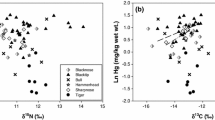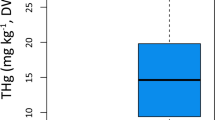Abstract
Concentrations of mercury (Hg) were quantified in muscle tissues of the Pacific angel shark, Squatina californica sampled from Southern Gulf of California, Mexico, considering total length, sex, diet and the dietary risk assessment. High Hg levels are typically associated with carnivorous fishes, however S. californica showed low Hg concentrations (<1.0 µg g−1) in muscle (0.24 ± 0.27 µg g−1 wet weight; n = 94). No effect of sex, total length and weight on Hg concentrations were observed in the shark (p > 0.05). Hg concentrations were highest in the darkedge mishipman: Porichthys analis (0.14 ± 0.08 µg g−1) and red-eye round herring Etrumeus teres (0.13 ± 0.05 µg g−1) relative to other prey species, which could suggest that Hg concentrations in S. californica were influenced by these species. Given the relatively low concentration of Hg across age-classes and sex, consumption of S. californica’s muscle tissue poses limited risk to humans.
Similar content being viewed by others
References
Adams DH, McMichael RH, Henderson GE (2003) Mercury levels in marine and estuarine fishes of Florida 1989–2001. 2nd edition revised. St. Petersburg, FL, Florida Marine Research Institute, (Florida Marine Research Institute. Technical Report, TR-9). http://aquaticcommons.org/120/1/TR9.pdf
Boening DW (2000) Ecological effects, transport, and fate of mercury: a general view. Chemosphere 40:1335–1351. doi:10.1016/S0045-6535(99)00283-0
Bonfil R (1994) Overview of world elasmobranch fisheries. FAO Fisheries Technical Paper No. 341. Rome
CONAPESCA (2013) Anuario Estadístico de Acuacultura y Pesca. Secretaría de Agricultura, Ganadería y Desarrollo Rural, Pesca y Alimentación. Comisión Nacional de Pesca. Mazatlán. http://www.conapesca.sagarpa.gob.mx/wb/cona/cona_anuario_estadistico_de_pesca
De Pinho AP, Guimarães JRD, Martins AS, Costa PAS, Olavo G, Valentin J (2002) Total mercury in muscle tissue of five shark species from Brazilian offshore waters: effects of feeding habit, sex, and length. Environ Res 89(3):250–258. doi:10.1006/enrs.2002.4365
Escobar-Sánchez O, Abitia-Cárdenas LA, Galván-Magaña F (2006) Food habits of the Pacific angel shark Squatina californica in the southern Gulf of California. Cybium 30(4):91–97
Escobar-Sánchez O, Galván-Magaña F, Abitia-Cárdenas LA (2011) Trophic level and isotopic composition of δ13C and δ15N of Squatina californica in the southern Gulf of California, Mexico. J Fish Aquat Sci 6(2):141–150. doi:10.3923/jfas.2011.141.150
Escobar-Sánchez O, Ruelas-Inzunza J, Patrón-Gómez JC, Corro-Espinosa D (2014) Mercury levels in myliobatid stingrays (Batoidea) from the Gulf of California: tissue distribution and health risk assessment. Environ Monit Assess 186(3):1931–1937. doi:10.1007/s10661-013-3506-7
Galvan-Magaña F, Nienhuis HJ, Klimley AP (1989) Seasonal abundance and feeding habits of sharks of the lower Golf of California, México. Calif Fish Game 75(2):74–84
Houserova P, Kuban V, Spurny P, Habarta P (2006) Determination of total mercury and mercury species in fish and aquatic ecosystems of Moravian rivers. Vet Med-US 51(3):101–110
JECFA (Joint FAO/WHO Expert Committee on Food Additives) 2010. Joint FAO/WHO Food Standards Programme, Committee of the Codex Alimentarius Commission, Thirty-third Session. http://www.fsis.usda.gov/PDF/2010-CAC/cac33_15e.pdf. Accessed 20 July 2010
Le Bourg B, Kiszka J, Bustamante P (2014) Mother-embryo isotope (δ15N, δ13C) fractionation and mercury (Hg) transfer in aplacental deep-sea sharks. J Fish Biol 84:1574–1581. doi:10.1111/jfb.12357
Lyons K, Carlisle A, Preti A, Mull C, Blasius M, O’Sullivan J, Winkler C, Lowe CG (2013) Effects of trophic ecology and habitat use on maternal transfer of contaminants in four species of young of the year lamniform sharks. Mar Environ Res 90:27–38. doi:10.1016/j.marenvres.2013.05.009
Magalhães MC, Costa V, Menezes GM, Pinho MR, Santos RS, Monteiro LR (2007) Intra- and inter-specific variability in total and methylmercury bioaccumulation by eight marine fish species from the Azores. Mar Pollut Bull 54:1654–1662. doi:10.1016/j.marpolbul.2007.07.006
Maz-Courrau A, López-Vera C, Galván-Magaña F, Escobar-Sánchez O, Rosiles-Martínez R, Sanjuán-Muñoz A (2012) Bioaccumulation and biomagnification of total mercury in four exploited shark species in the Baja California peninsula, Mexico. Bull Environ Contam Toxicol 88(2):129–134. doi:10.1007/s00128-011-0499-1
Moody JR, Lindstrom PM (1977) Selection and cleaning of plastic containers for storage of trace element samples. Anal Chem 49:2264–2267. doi:10.1021/ac50022a039
Moore CJ (2000) A review of mercury in the environment (its occurrence in marine fish). Office of Environmental Management. Marine Resources Division, South Carolina Department of Natural Resources. http://www.dnr.sc.gov/marine/img/mm_paper.pdf
Murphy GW (2004) Uptake of mercury and relationship to food habits of selected fish species in the Shenandoah river basin, Virginia. Dissertation, Virginia Polytechnic Institute
Newman MC, Unger MA (2002) Fundamentals of ecotoxicology. Lewis Publishers, Boca Raton, FL
NOM-027-SSA1-1993. Norma Oficial Mexicana (1993) Bienes y Servicios. Productos de la pesca. Pescados frescos-refrigerados y congelados. Especificaciones sanitarias. Published: June 17 1994
Pethybridge H, Cossa D, Butler ECV (2010) Mercury in 16 demersal sharks from southeast Australia: biotic and abiotic sources of variation and consumer health implications. Mar Environ Res 69:18–26. doi:10.1016/j.marenvres.2009.07.006
Romero-Caicedo A (2013). Biología reproductiva del tiburón angelito (Ayres, 1859) en el suroeste del Golfo de California. Dissertation. IPN-CICIMAR
Rose DA (1996) Shark fisheries and trade in the Americas, vol 1. North America. TRAFFIC, Cambridge
Ruelas-Inzunza J, Páez-Osuna F, Ruíz-Fernández C, Zamora-Arellano N (2011) Health risk associated to dietary intake of mercury in selected coastal areas of Mexico. Bull Environ Contam Toxicol 86:180–188. doi:10.1007/s00128-011-0189-z
Ruelas-Inzunza J, Escobar-Sánchez O, Patrón-Gómez JC, Moreno-Sánchez XG, Murillo-Olmeda A, Spanopoulos-Hernández M, Corro-Espinosa D (2013) Mercury levels in muscle and liver of selected ray species from Northwest Mexico. Mar Pollut Bull 77:434–436. doi:10.1016/j.marpolbul.2013.09.010
Storelli MM, Busco P, Marcotrigiano GO (2005) Mercury and arsenic speciation in the muscle tissue of Scyliorhinus canicula from the Mediterranean Sea. Bull Environ Contam Toxicol 75:81–88. doi:10.1007/s00128-005-0721-0
Villavicencio-Garayzar CJ (1996) Aspectos poblacionales del angelito, Squatina californica, AYRES, en Baja California, México. Rev Inv Cient Ser Cienc Mar 1:15–21
Acknowledgments
Thanks to Alejandro Escobar and Alejandra Espinoza for their help during the sampling and Manuel Soto for their help in the laboratory analysis. OES gratefully acknowledges the scholarship from PROMEP to pursue her postgraduate studies and thanks CONACyT for economic support through the program Cátedra CONACyT, Project 2137, FACIMAR-UAS. XGMS thanks the Instituto Politécnico Nacional (IPN) for economic support through the Contratación por Excelencia Program and EDI.
Author information
Authors and Affiliations
Corresponding author
Rights and permissions
About this article
Cite this article
Escobar-Sánchez, O., Ruelas-Inzunza, J., Moreno-Sánchez, X.G. et al. Mercury Concentrations in Pacific Angel Sharks (Squatina californica) and Prey Fishes from Southern Gulf of California, Mexico. Bull Environ Contam Toxicol 96, 15–19 (2016). https://doi.org/10.1007/s00128-015-1708-0
Received:
Accepted:
Published:
Issue Date:
DOI: https://doi.org/10.1007/s00128-015-1708-0




